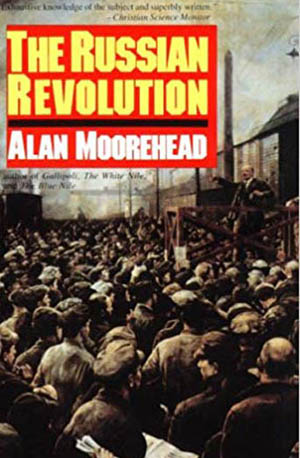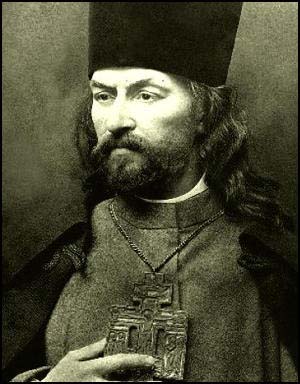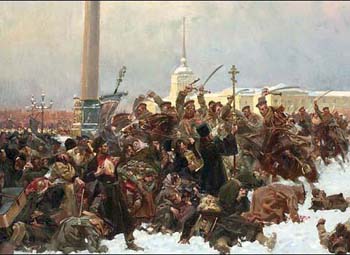Theology of History
 |
 |
 |
 |
 |
 |
 |
The ‘Orthodox’ Masquerade - V
Complicity of the Russian ‘Orthodox’ Church
with the Bolshevik Revolution

Moorehead confirms a corrupted 'Orthodox' church & its support of Communism
In his book The Russian Revolution, historian Alan Moorehead gives us an objective description of the events that led up to the 1917 Revolution. He warns his reader in the Preface that his work is based upon “a study of the revolutionary techniques, in particular the technique of the Bolshevik conspiracy.”
The Russian society prior to 1917 was extremely decadent, largely due to the immoral life of the “orthodox” clergy, who had no concern about teaching or following Christian virtues.
Moorehead confirms: “The Russia in which Nicolas II had grown up was filled with all kinds of ‘believers’ who swallowed the most bizarre creeds, going from minor religious deviations and sects who expected salvation from the drinking of milk to less harmless persons who specialized in drunken sex orgies, violence, collective mutilation and sometimes collective suicide.” (The Russian Revolution, Harper & Row Publishers, 1958, p. 302)
The first revolutionary action of manipulating the masses was led by Fr. Giorgi Gapon, the son of Ukrainian peasant parents living in Russia. As a young man, he “became very impressed by Tolstoy’s conception of nonviolence and his mild and loving anarchy as solution for the problems of the world. He entered the Orthodox Church, but he was really more a social reformer than a priest.

Russian ‘Orthodox’ priest and communist agitator Georgy Gapon
“In 1905, he was a striking looking man of 32, with a pointed black beard and thin and holy face, and he had become a popular idol. His Union of Russian Factory Workers was a national movement.” (ibid., pp. 53-55)
Gapon had the strength necessary to lead a demonstration of the masses in the streets and he called for his followers to gather at the Winter Palace in St. Petersburg to set the demands of the people before the Czar. The authorities became concerned, recalling the precedent of a terrorist assault made against Czar Alexander III in 1887 in which some conspirators – including a brother of Lenin named Alexander – were hanged.
The police feared that the manifestation orchestrated by Gapon could degenerate into a subversive act and tried to arrest him the day before the planned demonstration, but Gapon could not be found. The authorities were obliged to simply wait and see what the next day would bring.
On January 22, 1905, at the appointed time, a multitude of some 220,000 men, women and children gathered on the snowbound streets heading toward the Winter Palace. They sang “God save the Czar” as they moved along.
Gapon marched at their head carrying a petition for an eight hour work day, a minimum wage of one ruble a day, no unpaid overtime, and a constituent assembly. He planned to deliver these requests personally to the Czar while the multitude waited outside in front of the Palace. (ibid., p. 53-54)

Gapon, petition in hand, leads the demonstration;
many ‘orthodox’ priests supported his demands
The result of that demonstration was what became known as Bloody Sunday of 1905. The military officers called on the marchers to stop and disperse. Instead the multitude became upset and tried to force their way into the Czar’s Palace. As the workers repeatedly advanced and challenged the soldiers, the latter opened fire. About 500 persons died and thousands were wounded. (cf. ibid., pp. 54)
This episode marked the beginning of strikes, unrest and open terrorism. On February 17, Grand-Duque Sergei Alexandrovich, governor of Moscow, was murdered in front of the Kremlin. By the time the year ended, more than 1,500 authorities had been assassinated. (cf. ibid., p. 59)
Fr. Gapon removed his mask and showed his colors. He addressed a violent letter to the Czar: “The blood of the workers, their wives and children lies between you, O hurtful soul, and the Russian people. A moral relation can no longer exist between the two… May all the blood that was shed fall over you and yours, O executioner!” (ibid. p. 59)
He wrote another letter, a call to revolution, read at a meeting of liberals a day after that Bloody Sunday: “We no longer have a Czar. Today a river of blood divides him from the Russian people. It is time for the Russian workers to begin the struggle for the people’s freedom without him.”

A scene from Bloody Sunday 1905, which trigged the 1917 Communist Revolution
Thus, Bloody Sunday paved the way for an armed insurrection in 1905 and became the trigger for the 1917 Revolution. Although Trotsky was imprisoned and Gapon died in Finland, the revolutionaries advanced with well-studied steps in order to not raise too many reactions: “The Mencheviks [the softer faction in the Russian communist movement vs. the hardliner Bolsheviks] believed that the way was to move forward more slowly; to bring in first a liberal bourgeois government of young officers before advancing to Marxist Socialism.” (ibid., p. 62)
The role of Fr. Gapon as a forerunner of the 1917 Communist Revolution gives us a more objective picture of the role played by the “Orthodox” Church at the end of the Russian Monarchy.
Although by nature it is subservient to the temporal power, it is eager to change lords when it notes that the power is passing to other hands.
Continued

Posted February 18, 2019
______________________
______________________














